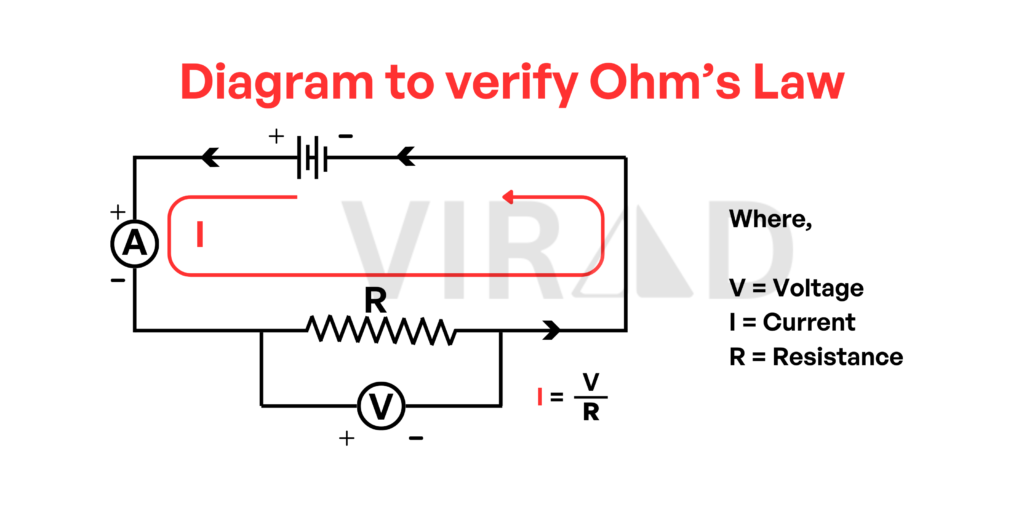Introduction to Ohm’s Law
Ohm’s Law is the cornerstone of electrical engineering and electronics, defining the relationship between voltage, current, and resistance in an electrical circuit. Named after German physicist Georg Simon Ohm, this fundamental principle states that the current flowing through a conductor is directly proportional to the voltage applied across it and inversely proportional to its resistance.
Why is Ohm’s Law Important?
Enables engineers to design and analyze circuits. Simplifies troubleshooting electrical systems. Forms the basis for understanding advanced concepts like power dissipation and Kirchhoff’s laws. Whether you’re a student, hobbyist, or professional, mastering Ohm’s Law is essential for working with everything from simple circuits to complex electronic devices.
Ohm’s Law Formula: V = IR
The mathematical expression of Ohm’s Law is:
V=I×R
Where:
V = Voltage (V)
I = Current (A)
R = Resistance (Ω)
Ohm’s Law Triangle (Infographic)
Visualize the formula using the Ohm’s Law triangle:
- Cover V with your finger to see I×R
- Cover I to find V ÷ R
- Cover R to calculate V ÷ I

Rearranged Formulas
Current: I=R/V
Resistance: R=I/V
Step-by-Step Examples
Example 1: Calculate Voltage
Problem: If a circuit has a current (I) of 2 A and a resistance (R) of 10 Ω, what is the voltage?
Solution:
V = I × R = 2 A × 10 Ω = 20 V
The voltage across the resistor is 20V.
Example 2: Find Resistance
Problem: A 12 V battery produces a current of 0.5 A in a circuit. What is the resistance?
Solution:
R = V/I
R = 12 V/ 0.5 A
R = 24 Ω
The resistance in the circuit is 24Ω.
Example 3: Determine Current
Problem: A 9V supply is connected to a 3Ω resistor. How much current flows?
Solution:
I = V/R
I = 9 V/3 Ω
I = 3 A
The current flowing through the resistor is 3A.
Practical Applications of Ohm’s Law
Ohm’s Law isn’t just theoretical—it’s used daily in electrical engineering and DIY projects.
- Circuit Design
Calculate component values (e.g., resistors, LEDs) to ensure safe current flow.
Design voltage dividers for sensors or microcontrollers. - Resistor Selection
Prevent component damage by choosing resistors with appropriate power ratings.
P = I 2 × R (Power dissipation formula)
- Troubleshooting
Diagnose short circuits (unusually high current) or open circuits (zero current).
Measure voltage drops to identify faulty components.
- Household Wiring
Determine wire gauge based on current requirements (e.g., for a 15A circuit, use 14-gauge wire).
Limitations of Ohm’s Law
While Ohm’s Law applies to ohmic materials (e.g., metals, resistors), it fails for non-ohmic materials where resistance changes with voltage or temperature.
Examples of Non-Ohmic Devices:
- Diodes: Conduct current only in one direction; resistance varies with voltage.
- LEDs: Require a minimum voltage (forward voltage) to operate.
- Transistors: Resistance depends on input signals and biasing.
Key Takeaway: Always verify if a component follows Ohm’s Law before applying
Ohm’s Law in Real Circuits (Infographic)

Flowchart Steps:
- Input Voltage Source: E.g., battery or power supply.
- Calculate Current: Use I = V / Rtotal
- Check Component Ratings: Ensure resistors or LEDs can handle the calculated current.
- Measure & Verify: Use a multimeter to confirm voltage, current, and resistance.
FAQs About Ohm’s Law
Q1: Can Ohm’s Law be used for AC circuits?
Yes, but only for resistive loads (e.g., heaters). For inductive/capacitive loads, impedance (Z) replaces resistance.
Q2: What happens if resistance is zero?
Current becomes infinite (short circuit), which can damage components or cause fires.
Q3: How does temperature affect resistance?
In metals, resistance increases with temperature (positive temperature coefficient).
Conclusion
Ohm’s Law is a vital tool for anyone working with electronics. By understanding V=IR, you can design circuits, troubleshoot issues, and avoid component failures. Remember to account for non-ohmic materials and always prioritize safety in your projects.
